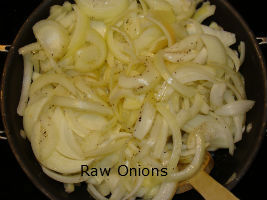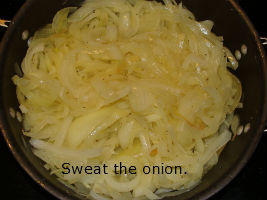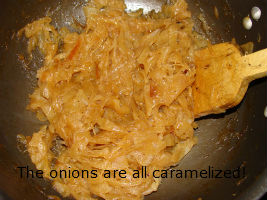
How to Caramelize an Onion
Caramelizing an onion is a great way to add flavor to a dish. It is also a basic culinary skill. One which we had to master in Basics class, the first class at Le Cordon Bleu. There are just a few steps, patience is required.
1. The first thing you need to do is peel and chop your onions. If you slice them with the grain (from top to bottom) they will hold their shape a little after you cook them and you will end up with pretty curls of onions in say, your French Onion Soup. If you chop them against the grain, or dice them, they will not hold their shape. This is better for things like French Onion Dip.
2. Next, put a little oil into a saute pan. I use about 1 tsp per pound of onions. You can use olive oil, canola oil, veggie oil, or clarified butter. I use olive oil unless it’s a special occasion in which case I use clarified butter.
3. Place your onions into the hot saute pan, sprinkle them with Kosher salt (3/4 -1 tsp per pound) and sweat them on medium-high heat. 
4. Reduce the heat to medium – low and allow your onions to slowly caramelize. The longer they cook, the more flavor you will bring out so don’t be in a hurry. It takes me around an hour and a half to caramelize mine (I like to take it really slow). It should take no less then 45 minutes though. As they are cooking, you will need to stir them occasionally. At least every ten minutes at first and then more often as they cook down. If they start to stick, add a little water, scrape the bottom and stir them (see notes below)
5. When they are a nice deep golden brown, they are done. Remove them from the pan. If you are not using them right away, cool them and store them in an airtight container in the fridge for up to four days.
What Happens When You Caramelize an Onion
 Sweating – (this is not when you work out with your onions) as the onions get hot, the water from inside forces its way out of the onion’s cells, this causes the cells to rupture and the water starts to evaporate (onions are about 75% water by weight), this is what causes them to soften at the beginning of cooking. The onions will begin to have a translucent appearance. This is called sweating your onions. If you have a recipe that says sweat your onions, this is what it is asking you to do. When they are “translucent”, move on to the next step.
Sweating – (this is not when you work out with your onions) as the onions get hot, the water from inside forces its way out of the onion’s cells, this causes the cells to rupture and the water starts to evaporate (onions are about 75% water by weight), this is what causes them to soften at the beginning of cooking. The onions will begin to have a translucent appearance. This is called sweating your onions. If you have a recipe that says sweat your onions, this is what it is asking you to do. When they are “translucent”, move on to the next step.
As the cells in the onion continue to break down, they release proteins, sugars, and aromatic compounds (mercaptans, disulfides, trisulfides, thiopenes and other long and impressive chemical names too). This is also when you, your hair, and your clothes start to smell like an onion :)! Mmmmm, you smell yummy! 
The water will continue to evaporate, and the temperature will continue to rise. When your little onions reach around 230°F they will begin to caramelize. During this time, there are a few things happening. The Maillard reaction begins to take place. This is when sugars, proteins, and enzymes interact and cause browning. It is the same effect that happens to toast and steak. It is not fully understood exactly what happens as there are hundreds of changes that take place so we aren’t going there. Another reaction that is going on is oxidation of the large sugar molecules (sucrose). As they break down more compounds are formed and more flavor is added to your onions. The sucrose (a large sugar molecule), is broken down into fructose and glucose. Fructose and glucose are sweeter on their own then sucrose. So, your onions get sweeter! Yay!
So, here’s a common problem that people run into when they’re caramelizing their onions. The smaller, pieces, and the ends can start to get dark to quick and stick to the pan. There is an easy solution to this. Before I tell you though, I’m going to warn you that a lot of people are going to tell you not to do this. I have done this myself and it works so…. ignore them :D! If your onions start to stick to the bottom of the pan, add a little water and scrape the bottom of the pan then stir them up. This is not for when you’ve burned them beyond recognition, but for when they are beginning to stick and are brown (not black) on the bottom. The reason this works is that the brown that’s stuck to the bottom of your pan, the over browned edges and the little pieces are brown and sticking from water-soluble, sugar based compounds that have been concentrated into one area. When you add the water and scrape and stir, you redistribute these sugars evenly. You can add water whenever it is needed, but if you find yourself constantly adding it, your heat is too high. Onions should be caramelized on medium – low for best results. There are ways to speed up caramelization like adding baking soda (which makes them break down faster and therefore release their sugars faster etc….etc….). You can also caramelize some table sugar and add it. I don’t recommend either of these things though. I think they come out nicer doing it the slower way. It’s your choice though. I’m not even eating at your house tonight :)!
Oh, one more thing. Which onions are best to caramelize? At first, you may think that obviously the sweet onions would be better right? Well, sweet onions do contain about 25% more sugar, but it is the lowered amount of lachrymators ((Propanethial S-oxide) the chemical that makes you cry) that make them have a sweeter taste. The lachrymators, when cooked, develop into more complex flavors, so the other varieties have a distinct advantage. It has been my experience that they caramelize about the same, but you get better flavor when using yellow, brown or red. I use a combination of the three when I make my French Onion Soup. I would also like to add that brown and yellow, in my opinion, get the prettiest color. The red ones turn a weird grayish green. They taste good though, so I still add them in.
So, now you have the basic information that you need to make perfectly caramelized onions. Have fun and make lots of delicious dishes! Happy Cooking :D!
Please enjoy this “how-to” chop an onion video!




